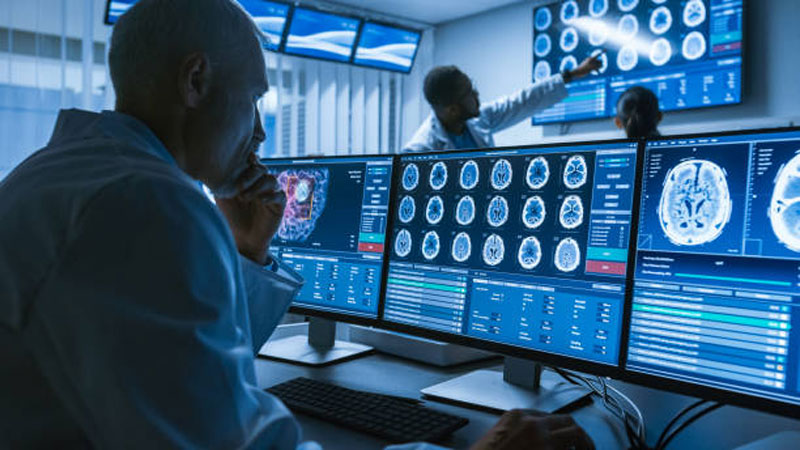CT (Computed Tomography) scan and MRI (Magnetic Resonance Imaging) both are medical techniques used to capture images of the inside of the body. Both of these are different in basics, as in a CT scan uses X-rays to capture images of organs and human skeleton while the MRI procedure makes use of radio waves to do the same job.
Both MRI and CT scans are considered low-risk procedures and are used side-by-side based on the need of the patient and the circumstances.
Let’s understand both MRI and CT scans better so that we can see the difference between the two of them. We will first talk about the process of MRI, and then we will proceed to the CT scan. We will sum up this article by comparing the two procedures in terms of risks and benefits.
MRI – Magnetic Resonance Imaging
The process of MRI uses magnets and radio waves to view organs and other vital objects inside the body. This procedure works by bouncing radio frequencies and magnetic fields off the water molecules and fat in the body. The radio waves then go to a receiver, which converts/translates them into an image of the body. This image can be used to diagnose health issues by doctors and medical professionals. MRI method is commonly used to check on:
- Brain
- Heart
- Breasts
- Joints
- Blood vessels
MRI procedure needs a patient to enter a narrow tunnel and lie still in it until the process gets over. This machine makes a lot of noise, and patients are often provided with headphones to make the noise bearable.
CT Scan – Computed Tomography
CT scans, also known as CAT scans, use huge X-ray machines that are typically used to find:
- Tumors
- Bone fractures
- Cancer
- Internal bleeding
This method requires a patient to lie down on a table that moves through the CT machine. It takes cross-sectional pictures of the inside body and helps doctors get a better understanding of the underlying issues behind a health problem.
CT scans were very popular before the arrival of the MRI. Now, MRI has taken center stage because of the kind of details it can provide. CT scan or CAT scan is still in use and is the only choice when it comes to certain conditions and circumstances. It is also widely used because it is less expensive than the MRI.
CT Scan vs MRI
What is the difference between a CT Scan and MRI in terms of risks? Here is the answer.
CT scan and MRI both pose a certain amount of risk based on how they are performed or the type of imaging used on a patient. The risks associated with CT scan are exposure to radiation, potential reaction to the dyes used in the process, and harm to unborn babies.
MRI can cause issues like hearing problems caused by loud noises in the machine, an increase in body temperature because of long sessions, reaction to the metals produced by magnets, and claustrophobia. An MRI can quickly become a problematic issue if the patient has a pacemaker, eye implants, artificial joints, and an IUD.
What is the difference between a CT Scan and MRI in terms of Benefits? Read on.
Both MRI and CT scan can look inside the body and check for health problems related to vital organs. A CT scan is faster than the MRI when it comes to providing pictures of the skeletal structure, tissues, and organs. On the other hand, MRI provides for high-resolution images that help doctors determine abnormal growths and masses within the body. In short, the CT scan is a faster process, and MRI provides pictures with better clarity.
MRI or CT Scan – Which is Better?
Both MRI and CT scans are adequate procedures in different ways. A CT scan is ideal when the doctor needs quick reports and can manage without high-quality images. Similarly, an MRI is a good option for in-depth analysis and better understating of a health issue that may be missed on a CT scan.
A doctor is usually the best person to decide which procedure will be best for a patient. They can keep aside points like price and take a call on what’s best for the patient’s health. Moreover, certain issues can only be diagnosed by an MRI like torn ligaments, soft tissue issues, and herniated disks. There’s no point discussing which method to go within such cases.
Conclusion
Both CT scan and MRI are low-risk procedures that can help doctors find a problem and help the patient at the earliest. Both these procedures let a doctor diagnose specific conditions, so it will be best to follow a doctor’s recommendation. Ask questions about your health problem and the process if you have doubts, so that you can better understand why you are going for an MRI or a CT scan.
You can get your MRI done at a private center like Express MRI. It is a state-of-the-facility that is equipped with the latest MRI machines. Express MRI works with a straight-forward vision, which is to provide the highest quality MRI scans at the lowest possible cost. Book your MRI online by logging on to their website and take your first step towards good health.
Comments
comments